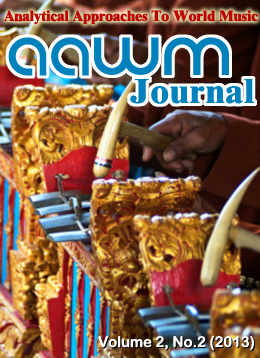 |
| |
 |
 |
|
 |
 |
|
AAWM JOURNAL Volume 2, No. 2 (2013) |
 |
 |
| Volume 2, No. 2 (2013) |
| |
 |
 |
| The Pairwise Variability Index as a Measure of Rhythm Complexity |
| Godfried T. Toussaint (New York University, Abu Dhabi) |
| The normalized pairwise variability index (nPVI) is a measure of the average variation (contrast) of a set of distances (durations) that are obtained from successive ordered pairs of events. It was originally conceived for measuring the rhythmic differences between languages on the basis of vowel length. More recently, it has also been employed successfully to compare large-scale rhythm in speech and music... more >> |
| |
 |
 |
| Tuning Procedures in Ancient Iraq |
| Sam Mirelman (School of Oriental and African Studies, University of London) |
| A manual for tuning a lyre/harp from ancient Iraq (or "Mesopotamia"), dating to the early second millenium BCE, uses a cyclical procedure of tuning pairs of strings (dichords). It is the earliest known example of music theory, predating anything comparable from other cultures by approximately one millenium. This manual enables a lyre/harp player to use a diagnostic method of determining the current mode or tuning of the lyre; it directs the musician to transform the instrument from one mode to another, through a series of tightening or loosening dichords (pairs of open strings)... more >> |
| |
 |
 |
| Preliminary Remarks on a Helical Representation of Time |
| Andrew McGraw (University of Richmond) |
| In this article I describe a system for representing musical timing as a helix, enabling the three-dimensional visualization and printing of both micro- and piece-length temporality. Examples from the Balinese gamelan repertoire serve as the principal examples. I describe the functionality of Mathematica code developed to produce the visualizations, providing publically accessible links to the code, data, and output files. Rather than a study presenting extensive findings, this article outlines a method and describes preliminary examples... more >> |
| |
 |
 |
| Reflections on Composing for Balinese Gendér Wayang: The Birth of Kala |
| Nicholas Gray (School of Oriental and African Studies, University of London) |
| This paper discusses aspects of composing for a specific type of Balinese gamelan ensemble known as gendér wayang, a quartet of metallophones that accompanies shadow puppet plays and life-cycle rituals. The author is a composer and ethnomusicologist who spent many years studying this tradition and has conducted research on traditional compositional methods for the ensemble. He also teaches and leads a gendér wayang ensemble in London. The instrument's technical difficulty and the highly complex, rhythmically ambiguous nature of the traditional repertoire make this a particularly challenging ensemble to compose for... more >> |
| |
 |
 |
| Toward a New Comparative Musicology |
| Patrick E. Savage (Tokyo University of the Arts) and Steven Brown (McMaster
University) |
| We propose a return to the forgotten agenda of comparative musicology, one that is updated with the paradigms of modern evolutionary theory and scientific methodology. Ever since the field of comparative musicology was redefined as ethnomusicology in the mid-twentieth century, musicologists have all but abandoned many features of its original research agenda, not least the overarching goal of cross-cultural musical comparison... more >> |
|
|
 |
|
 |
 |
|



